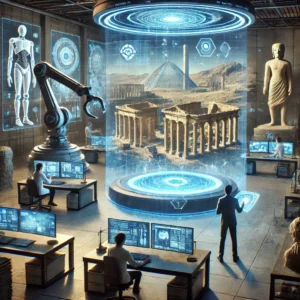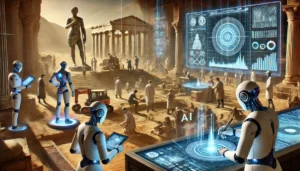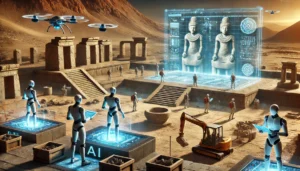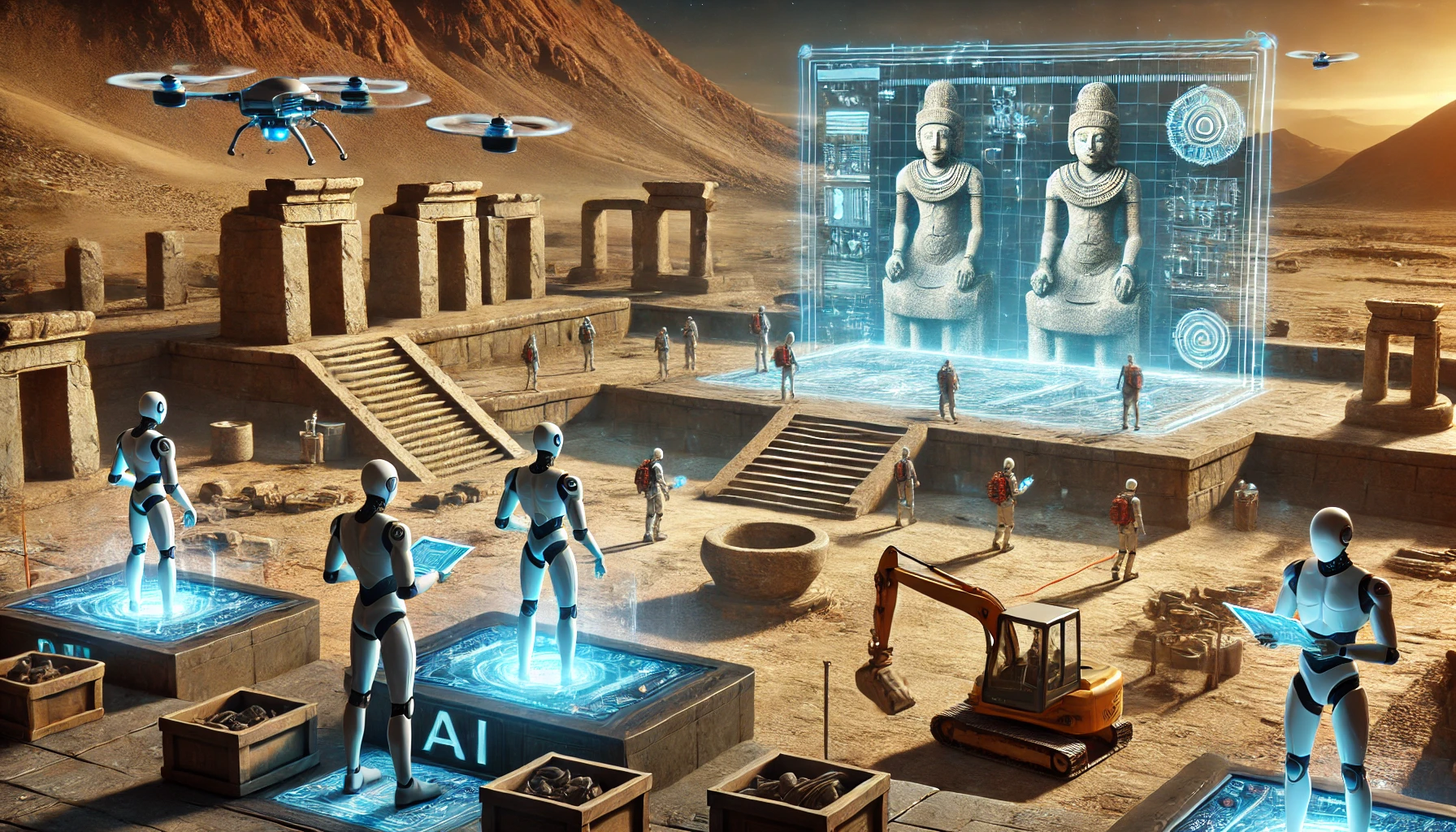
The Role of AI in Ancient History Research
The Role of AI in Ancient History Research and Archaeology
In recent years, Artificial Intelligence (AI) has emerged as a powerful tool in the field of ancient history research and archaeology. By leveraging machine learning, computer vision, and big data analysis, AI is revolutionizing the way scholars interpret historical data, decode ancient texts, and uncover lost civilizations. This technological advancement is accelerating discoveries and offering new perspectives on humanity’s past.
AI in Deciphering Ancient Texts
One of the most significant applications of AI in historical research is the deciphering of ancient scripts and languages. Many ancient texts, such as Sumerian cuneiform, Egyptian hieroglyphs, and the Indus Valley script, remain partially or entirely undeciphered. AI-powered natural language processing (NLP) models can analyze vast amounts of data, recognizing patterns that may elude human researchers.
For instance, Google’s DeepMind and MIT researchers have developed AI models capable of reconstructing missing parts of ancient inscriptions and translating extinct languages by identifying linguistic patterns. AI is also assisting in understanding fragmented manuscripts, such as the Dead Sea Scrolls and ancient Greek papyri, making them accessible to a wider audience.
Moreover, AI is being employed in optical character recognition (OCR) to digitally transcribe ancient manuscripts, ensuring their preservation. By using AI-assisted handwriting analysis, researchers can distinguish between different scribes and periods, providing deeper insights into historical documentation practices.
AI in Archaeological Discoveries
AI is playing a crucial role in identifying archaeological sites and artifacts. Traditionally, archaeologists relied on manual excavation and surface surveys, but AI-powered satellite imaging and LiDAR (Light Detection and Ranging) technology are transforming this process.
By analyzing satellite imagery, AI can detect subtle changes in the landscape that indicate buried structures. In recent years, AI-driven remote sensing has led to the discovery of lost cities in regions such as the Amazon rainforest and the deserts of the Middle East. Additionally, LiDAR technology has revealed ancient Mayan cities hidden beneath dense jungle canopies, enabling researchers to explore these sites without disturbing their surroundings.
AI-driven geospatial analysis is further aiding in detecting patterns of human settlement. By analyzing topographical, geological, and hydrological data, AI helps archaeologists pinpoint areas where ancient civilizations may have flourished, optimizing resource allocation for excavation.
Table of Contents

The Role of AI in Ancient History Research
AI in Artifact Identification and Restoration
AI is also aiding in artifact identification and restoration. Museums and researchers use AI algorithms to analyze pottery shards, sculptures, and paintings, helping to determine their origins, authenticity, and historical context.
For instance, AI image recognition tools can compare an artifact’s design with existing databases to identify its cultural and chronological significance. AI is also being used to digitally restore damaged or eroded artworks, reconstructing missing elements with remarkable accuracy. This technology has proven particularly useful in restoring faded frescoes, ancient manuscripts, and even cracked statues.
Furthermore, AI-assisted 3D modeling enables researchers to recreate artifacts and monuments in digital form, allowing for virtual reconstructions of historical sites. This not only aids in visualization for research but also provides immersive educational experiences for the public through virtual reality (VR) and augmented reality (AR) applications.
AI and Predictive Archaeology
Predictive archaeology is another groundbreaking application of AI. By analyzing past excavation data, AI can predict where future archaeological sites might be located. These predictions are based on factors such as geographical conditions, historical records, and settlement patterns. This approach helps researchers prioritize excavation sites, saving time and resources while minimizing damage to cultural heritage.
For example, AI models have helped archaeologists locate potential Viking settlements in North America and previously unknown Roman structures in Europe. By integrating AI with Geographic Information Systems (GIS), experts can create digital maps that visualize past civilizations in unprecedented detail.
Additionally, AI-based climate modeling helps predict the impact of environmental changes on archaeological sites, assisting in their long-term preservation. By forecasting erosion, flooding, and other threats, AI plays a key role in heritage conservation efforts.
Challenges and Ethical Considerations
Despite its many advantages, the use of AI in ancient history research and archaeology presents several challenges. AI models require extensive and high-quality data for training, which may not always be available for ancient artifacts and texts. Additionally, there is a risk of misinterpretation if AI algorithms make inaccurate predictions or draw conclusions without human oversight.
Ethical concerns also arise regarding the ownership and accessibility of AI-generated discoveries. Should AI-driven findings be considered the intellectual property of the researchers who develop the models, or should they be freely shared for the benefit of global heritage? Moreover, the potential commercialization of AI tools for historical research could lead to disparities in access to information among different institutions and countries.
There is also the question of AI’s role in the destruction of cultural heritage. If AI-driven excavations uncover previously unknown sites, how should governments and organizations ensure their ethical excavation and preservation rather than their exploitation for commercial or political purposes?
Future Prospects and Conclusion
The integration of AI into ancient history research and archaeology is unlocking new dimensions of knowledge, offering innovative solutions to age-old mysteries. From deciphering lost languages to discovering hidden civilizations, AI is reshaping our understanding of the past. However, it is crucial to strike a balance between technological advancement and ethical responsibility to ensure that AI serves as a tool for historical preservation rather than exploitation.
Looking ahead, AI will continue to refine its capabilities, possibly integrating with robotics to aid in autonomous excavations, reducing the risks involved in handling delicate artifacts. AI-driven genetic research might also provide insights into ancient populations by analyzing DNA from preserved remains, bridging gaps in human history.
As AI continues to evolve, its role in uncovering the secrets of antiquity will only become more profound, bridging the past with the future in unprecedented ways. By embracing AI responsibly, scholars and historians can revolutionize the study of ancient history while ensuring that cultural heritage is preserved for generations to come.

The Role of AI in Ancient History Research
FAQs on “Unveiling the Past: The Transformative Role of AI in Ancient History and Archaeology”
Understanding AI’s Role in Historical Research
- How is AI transforming the study of ancient history?
AI is revolutionizing historical research by processing and analyzing vast amounts of data from ancient manuscripts, inscriptions, and artifacts. It can identify connections between civilizations, translate ancient languages, and generate predictive models about historical events and migrations.
- Can AI reconstruct lost civilizations?
AI can assist in reconstructing lost civilizations by analyzing historical records, artifacts, and environmental data. It helps archaeologists model ancient cities, predict settlement patterns, and even digitally recreate architectural structures from ruins.
- How does AI help in deciphering ancient texts?
AI-powered natural language processing (NLP) algorithms analyze linguistic patterns and compare them with known languages to decipher scripts. Projects like Google’s DeepMind have successfully used AI to reconstruct damaged cuneiform tablets and faded manuscripts.
- What is AI’s role in preserving historical documents and artifacts?
AI enhances historical preservation by digitally restoring damaged manuscripts, identifying missing fragments, and predicting the original appearance of faded texts. Machine learning also aids in detecting forgeries and preserving cultural heritage.
AI in Archaeological Discoveries
- How does AI contribute to archaeological excavations?
AI helps in site detection using satellite imagery, LiDAR scans, and geospatial analysis. It can predict the most promising excavation sites by recognizing hidden patterns in terrain and soil composition, reducing time and costs for archaeologists.
- Can AI analyze artifacts more efficiently than humans?
AI can quickly classify artifacts by material, style, and historical period. Machine learning models are trained on thousands of known artifacts to identify similarities and possible origins, speeding up the cataloging process.
- How does AI assist in 3D reconstruction of ancient structures?
AI-driven 3D modeling software reconstructs lost or damaged structures using historical references and architectural principles. It allows researchers to visualize how buildings, cities, and monuments may have looked in their prime.
- What role does AI play in underwater archaeology?
AI-powered underwater drones and sonar mapping techniques help explore submerged cities and shipwrecks. Machine learning algorithms analyze oceanic data to identify potential sites hidden beneath the sea floor.
AI and Ancient Languages
- Can AI fully translate lost languages?
While AI can identify patterns and compare unknown scripts with existing languages, it requires human expertise for context. AI has made significant progress in deciphering ancient Egyptian, Mayan, and cuneiform texts, but full translations still need expert validation.
- How does AI handle incomplete or fragmented texts?
AI algorithms can predict missing words and phrases by analyzing surrounding text patterns. It reconstructs incomplete manuscripts by filling in gaps with plausible words based on historical and linguistic probabilities.
AI, Dating, and Historical Timelines
- Can AI determine the age of artifacts and fossils?
AI assists in dating artifacts by analyzing material composition, weathering patterns, and comparing them with known historical data. It refines dating techniques like radiocarbon dating and dendrochronology (tree-ring dating).
- How does AI improve the accuracy of historical timelines?
By cross-referencing data from multiple sources—such as climate records, trade patterns, and genetic studies—AI creates more accurate historical timelines, clarifying the sequence of events and migrations.
AI and Ethical Concerns
- What are the ethical concerns of using AI in archaeology?
AI raises concerns about data ownership, cultural heritage rights, and the potential loss of human expertise. Indigenous communities and historians worry about the digital reproduction of cultural artifacts without proper attribution.
- Does AI contribute to the looting of ancient sites?
There is a risk that AI-driven mapping tools could be misused to locate and exploit archaeological sites. Ethical frameworks and legal regulations must ensure that AI serves preservation rather than illicit artifact trade.
Future of AI in History and Archaeology
- How will AI shape the future of archaeology?
AI will continue to advance excavation techniques, automate artifact classification, and refine historical interpretations. Future developments may include AI-driven robotic archaeologists and real-time site analysis through augmented reality.
- Can AI predict undiscovered historical sites?
Yes, AI models analyze environmental and historical data to predict where undiscovered sites may be located. This predictive approach has already led to major discoveries in South America, Egypt, and Mesopotamia.
- Will AI ever replace human historians and archaeologists?
No, AI is a tool that enhances research but cannot replace human intuition, cultural understanding, and historical interpretation. The collaboration between AI and experts will continue to push the boundaries of knowledge.
Summary
AI is revolutionizing the study of ancient history and archaeology by enhancing research, discovery, and analysis. Through machine learning, image recognition, and predictive modeling, AI aids in deciphering ancient scripts, reconstructing lost civilizations, and identifying archaeological sites with unprecedented accuracy. By analyzing vast datasets, AI accelerates artifact classification and helps preserve historical records digitally. This transformative technology not only deepens our understanding of the past but also opens new frontiers in historical exploration, making archaeological research more efficient and accessible.
Unlock the Ancient Wisdom of Sanatan Dharma – Join Us on YouTube!
👉 Subscribe now to Prachin Sanatan Dharma and embark on a journey of enlightenment.
Explore timeless teachings, spiritual insights, and cultural richness on our YouTube channel, Prachin Sanatan Dharma. Dive deep into the essence of Sanatan Dharma through captivating videos that inspire and educate.
Related Articles
- Restful Nights: Ayurvedic Remedies and Traditional Indian Practices to Overcome Insomnia and Late-Night Habits
- The Tridevi: Lakshmi, Saraswati, and Parvati – Their Roles and Powers
- “Divine Creatures of Ancient Indian Scriptures: Exploring the Role of Animals in the Vedas, Puranas, and Mahabharata”
- Nature and Spirituality: Exploring the Sacred Essence of the Himalayas, Ganga, and Other Natural Wonders”
- “Reviving the Gurukul System: Relevance and Lessons for Modern Education”
- “Exploring Greek and Indian Mythology: Similarities Between Greek and Indian Mythology “
- “Embracing Sattvic Living: Harmonizing Mind, Body, and Soul Through Food and Lifestyle”
- “Charity and Prosperity: Exploring the Concept of Daan and Its Financial Relevance in Modern Life”
- How to Build an Eco-Friendly Home Inspired by Vastu Shastra
- Comparison of Ancient and Modern Sports: How Traditional Sports Have Influenced Contemporary Games
- “Timeless Lessons from Ancient Tales: Linking Samudra Manthan and Ganga’s Descent to Modern Ecological Challenges”
- “Reviving Sanskrit: How AI is Preserving Ancient Languages for the Future”
- “Mathura: The Sacred Land of Lord Krishna’s Divine Leelas”
- Investing for Future Generations: Lessons from Indian Traditions on Legacy Building and Wealth Preservation
- “Ancient Indian Wisdom: Timeless Lessons for Tackling Today’s Climate Crisis”
- “Artificial Intelligence and Spirituality: Transforming Ancient Practices for the Modern World”
- “Gold and Real Estate in India: Timeless Assets Shaping Financial Strategies”
- Tradition Meets Innovation: The Evolution of Technology in Hindu Rituals
- End-of-World Myths: Exploring Kali Yuga in Hinduism and Ragnarök in Norse Mythology
- Garuda, Pegasus, and Dragons: The Universal Ties of Mythical Beasts Across Cultures
- “Ancient Vimanas: Mythical Flying Machines or Evidence of Advanced Technology?”
- Time Travel in Hindu Mythology: The Fascinating Tales of Kakudmi and King Raivata
- “Divine Feminine Power in Hindu Mythology: The Legends of Durga, Saraswati, and Lakshmi”
- “Divine Beings of Sanatan Dharma: The Spiritual Significance of Sacred Animals in Hinduism”
- “Symbolism in Mythological Art: Unlocking Hidden Meanings in Ancient Temple Carvings”
- “Exploring Technological Advancements in Ancient India and Civilizations: Vimana, Metallurgy, & Water Management systems”
- Unveiling the Mysteries: Ancient Temples of Sanatan Dharma , Mysterious Temples of India
- “The Scientific Knowledge of Sanatan Dharma: Ancient Wisdom Meets Modern Science”
- Ancient Indian Sports and Games: Celebrating a Legacy of Skill, Strength & Strategy”
- “Exploring the Cosmic Link: The Connection Between Astronomy and Vedic Astrology”
- The Power of Sanskrit: Unlocking the Divine Language of the Gods
- “The End of Kaliyuga: A Sanatan Insight into the World’s Final Chapter”
- Explore more articles on Prachin Sanatan Yuga.
The Role of AI in Ancient History Research The Role of AI in Ancient History Research The Role of AI in Ancient History Research The Role of AI in Ancient History Research The Role of AI in Ancient History Research The Role of AI in Ancient History Research The Role of AI in Ancient History Research The Role of AI in Ancient History Research The Role of AI in Ancient History Research The Role of AI in Ancient History Research
The Role of AI in Ancient History Research The Role of AI in Ancient History Research The Role of AI in Ancient History Research The Role of AI in Ancient History Research The Role of AI in Ancient History Research The Role of AI in Ancient History Research The Role of AI in Ancient History Research The Role of AI in Ancient History Research The Role of AI in Ancient History Research The Role of AI in Ancient History Research
The Role of AI in Ancient History Research The Role of AI in Ancient History Research The Role of AI in Ancient History Research The Role of AI in Ancient History Research The Role of AI in Ancient History Research The Role of AI in Ancient History Research The Role of AI in Ancient History Research The Role of AI in Ancient History Research The Role of AI in Ancient History Research The Role of AI in Ancient History Research
